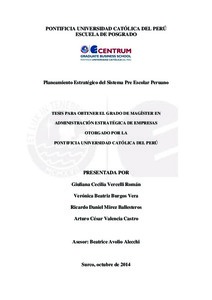| dc.contributor.advisor | Avolio Alecchi, Beatrice Elcira | |
| dc.contributor.author | Vercelli Román, Giuliana Cecilia | es_ES |
| dc.contributor.author | Burgos Vera, Verónica Beatriz | es_ES |
| dc.contributor.author | Mirez Ballesteros, Ricardo Daniel | es_ES |
| dc.contributor.author | Valencia Castro, Arturo César | es_ES |
| dc.date.accessioned | 2017-06-20T23:22:49Z | |
| dc.date.available | 2017-06-20T23:22:49Z | |
| dc.date.created | 2014 | |
| dc.date.issued | 2017-06-20 | |
| dc.identifier.uri | http://hdl.handle.net/20.500.12404/8865 | |
| dc.description.abstract | La infancia temprana ha sido considerada como una de las etapas más importantes en
el desarrollo humano. Durante sus primeros años, los niños desarrollan habilidades
cognitivas, emocionales y sociales que son críticas en los siguientes años de educación, y que
brindan una ventaja significativa a los niños que asisten a un colegio pre escolar, sobre los
que no tienen esta oportunidad. A nivel mundial, los países con los mejores sistemas de
educación han adoptado políticas para desarrollar sus sistemas educativos pre escolar.
Aunque existen diferencias en las políticas adoptadas por estos países, hay factores claves
que son comunes, como la calidad de la educación y el acceso garantizado que tienen todos
los niños al mismo nivel de educación.
La educación es aún una de las principales preocupaciones en el Perú. El país ha
desarrollado diferentes estrategias que parecen haber sido insuficientes para mejorar la
calidad de su sistema educativo. El presente plan estratégico para el Sistema Pre Escolar
peruano plantea alcanzar objetivos relacionados con los factores clave considerados por otros
países con sistemas exitosos, pero adaptados a la realidad del país. Las estrategias propuestas
también consideran la importancia de la familia para mejorar los resultados del proceso
educativo, el uso del juego e infraestructura para crear un entorno creativo, y de la tecnología
como una facilitadora del aprendizaje del niño, así como para administrar colegios de una
manera más eficiente.
Debido a su importancia, el Sistema Pre Escolar deber priorizarse, brindando una
educación de calidad para los niños entre 3 y 5 años, tanto en el sector público como privado.
Los objetivos planteados alcanzan, además, tanto al sector rural como urbano, asegurando la
equidad de la educación. Si el Perú logra desarrollar un Sistema Pre Escolar exitoso, éste
contribuirá con un mejor sistema educativo como conjunto, así como con una mejor sociedad | es_ES |
| dc.description.abstract | Early childhood has been considered as one of the most important stages in human
development. During these first years, children develop cognitive, emotional and social
abilities, which are also critical for the next years in school and provide a significant
advantage to the children who attend a preschool, over those who do not have the
opportunity. Around the world, there are countries that have adopted policies to improve
their preschool system and are well known to have a prestigious educational system. Even
though there are some differences among the systems adopted by each country, there are
common key factors, like the quality of education and guaranteed access for all children to
the same level of education.
Education is still one of the major concerns in Peru. The country has developed
different strategies which seem not to be enough to improve the quality of the educational
system. This strategic plan for the Preschool System in Peru is intended to achieve goals that
are closely related to the key factors that were considered for other countries with successful
systems, but adapted to the current Peruvian environment. The proposed strategies also
consider the importance of family to improve the results of the educational process, the use of
plays and infrastructure to have a more creative environment, and technology as a driver to
help children to learn, and to manage schools more efficiently.
Due to its importance, Preschool System should be prioritized, providing an education
with quality to all children between 3 and 5 years, no matter if it is public or private. The
objectives also reach urban and rural areas, to guarantee an equal education. If Peru has a
successful Preschool System, it will definitively contribute to a better educational system as a
whole, and a better society as well | es_ES |
| dc.language.iso | spa | es_ES |
| dc.publisher | Pontificia Universidad Católica del Perú | es_ES |
| dc.rights | info:eu-repo/semantics/openAccess | es_ES |
| dc.rights.uri | http://creativecommons.org/licenses/by-nc-nd/2.5/pe/ | * |
| dc.subject | Educación preescolar -- Perú | es_ES |
| dc.subject | Planificación estratégica | es_ES |
| dc.title | Planeamiento estratégico del sistema pre escolar peruano | es_ES |
| dc.type | info:eu-repo/semantics/masterThesis | es_ES |
| thesis.degree.name | Maestro en Administración Estratégica de Empresas | es_ES |
| thesis.degree.level | Maestría | es_ES |
| thesis.degree.grantor | Pontificia Universidad Católica del Perú. CENTRUM | es_ES |
| thesis.degree.discipline | Administración Estratégica de Empresas | es_ES |
| renati.discipline | 413307 | es_ES |
| renati.level | https://purl.org/pe-repo/renati/level#maestro | es_ES |
| renati.type | https://purl.org/pe-repo/renati/type#tesis | es_ES |
| dc.publisher.country | PE | es_ES |
| dc.subject.ocde | https://purl.org/pe-repo/ocde/ford#5.02.04 | es_ES |






